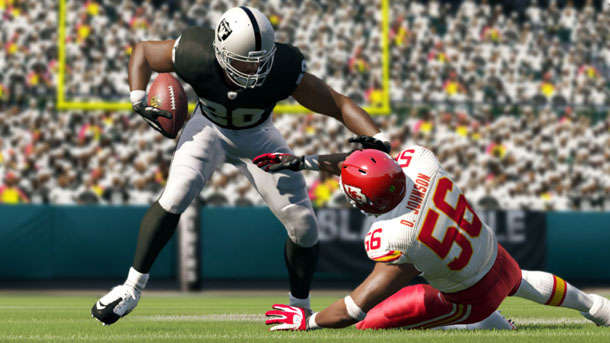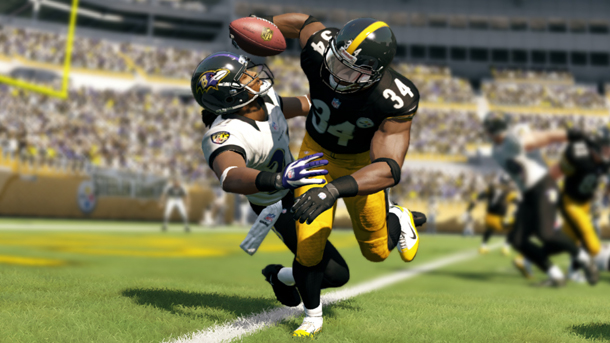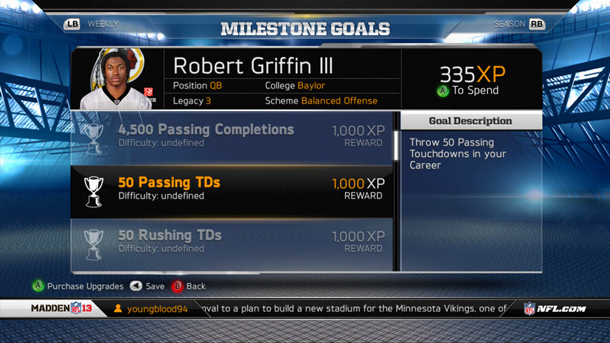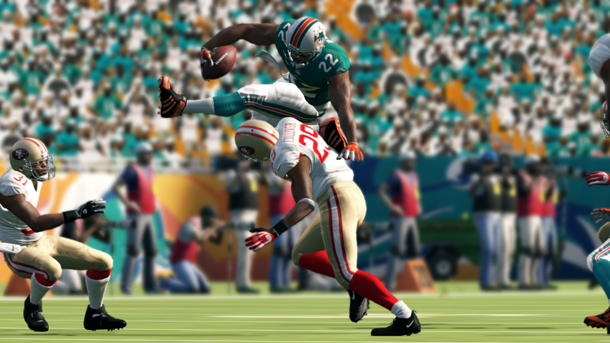
The score is 14-14, just before the end of the first quarter. Up until this point it’s been a quarterback’s dream game, with deep passes and chips eating away at coverage all evening. The yardage is being racked up, with a sure-fire career day incoming. But, I’m beginning to notice that one of my wide receivers is being manhandled on the right side, and I’m wondering why no hands-to-the-face penalties have dropped.
Brandon Jacobs, positions himself in the backfield to sweep to the right, the call for another pass about to take place: four verticals. The D-line makes a shift to the left.
“Audible!”
Jacobs, now directly behind the QB, sees a hole straight ahead. The 49er knows his opponents well, knows what makes them tick.
“Hut! Hike!”
Jacobs grabs the ball, running forward. His head now down, he blasts into the Giants’ lineman, bouncing left and right, his shoulders turning and torso twisting. One step left, one step right, his powerful legs seem to withstand being taken out, mostly due to the momentum he carries. The ball propels him forward, like a locomotive. Then, leaping, as if trying to go through a defender. No luck. In mid-air he seems less than majestic, like a goose that’s been shot out of the sky. Ball clutched at his side, he lands with a thud on the ground. The Giants defense responds by rolling up, pushing themselves to standing positions as if ready to pounce.
Until.
Until the field around Jacobs clears. Still on his back, and shaking off pain, his form lies across the 35 yard line. First down. FIRST DOWN.
A little dramatic, yes, but that single trial of an average field audible in Madden NFL 13 changed my entire feel for the game. One of the gripes I’ve always had with the series was that it disconnected me from the game on the digital field, my players feeling more like chess pieces than action figures I’ve owned for years. Madden 13 takes three huge steps towards creating as much of an enjoyable bond as possible: the Infinity Engine, Connected Careers, and Kinect. Yes, Kinect.

Infinity Engine
The Oscar-worthy performance above took place when I laid my hands on an Xbox controller at an event the night before E3. It wouldn’t have been possible in previous Madden games were it not for the addition of the new Infinity Engine, the most noticeable on-the-field change. The physics engine aims to replicate “momentum, contact, and even personality based on player stats.” Personality? At one point in a different matchup one of my runs was cut short early, until I noticed that my RB had actually placed his hand down on the field to prevent being downed. He was able to roll back up and continue forward for 3 more yards. The “personality” there came with specific stats that the player had developed through Connected Careers mode (more on that later). Call it “experience” in real life.
The engine is still being worked on, and is similar to FIFA’s Player Impact Engine in at least the “impact” portion; body parts flex and move as if really banging into each other, and I noticed absolutely minimal clipping. It provides a visual sense of reality, but does wonders for actual gameplay. When receivers and defenders bang against each other going up for a toss, legs and shoulders bumping can affect the momentum of the rest of the body, contorting players into or away from the ball. The plays change almost dynamically, forcing me to adjust my tactics if I really want to squeeze out that extra yard or catch that errant pass. Unless you’re Calvin Johnson, of course. CJ seemed to catch EVERYTHING I threw at him. Granted, he’s six-five and weighs in at 236, so there aren’t many defenders than can stop him in the game or on an actual NFL field.
The engine is still being worked on, meaning that some of the horrific knee bends that I saw in this demo were hopefully going to get fixed for release. Lineman still seemed to move a little like cyborgs, and quarterbacks didn’t show enough mobility, though that could have been because of the teams I chose. All in all, it feels fresh and realistic, and extremely smooth. I compare it to the quality of a PIXAR film versus a Disney CGI film – PIXAR (Madden 13) has more life in it, more emotion when compared to Disney (Madden 12). It’s a huge difference that becomes more noticeable over time.
Connected Careers
Connected Careers was explained to me as “killing off every other mode we’ve had” by EA’s designers. I freaked. However, taking a step back and looking at those modes I came to realize that they hadn’t really changed over the last 3 years. Connected Careers replaces traditional Franchise, Career, Superstar, online/offline leagues, and even single-player, combining them all into one giant mode. The mode lets players choose to be one of the athletes or coaches, current or retired, and maintain their entire career across single-player or in leagues of up to 32 people (offline for coaches, though). Athletes can even retire and un-retire throughout the seasons, at any point, just like Brett Favre.

As an athlete, it plays similar to Superstar Mode and focuses on the development of one player. As a coach the mode becomes what we’re more accustomed to when controlling the entire team. It’s a persistent world too, linking all of the created athletes and coaches together. It’s not just about the one team I’m playing as (hint: it’s ALWAYS the Lions) — if I get fired as a coach and get picked up by another team, there’s more of a feeling of accomplishment when I take down my former employer. It’s almost like an MMO based around football.
The real hook is the mode’s lite Role Playing element. In CC, as players and coaches complete tasks and perform on or off the field they’re awarded experience points that can be used to improve their statistics. Bringing a player up and making them a star gives us a huge sense of ownership that can come crashing down if he ends up traded to another team and we’re forced to read the faux in-game Tweets about how well he’s doing.

Kinect
Whenever the words “Better With Kinect” show up on a game’s box, I usually chuckle. I know the truth. It never works as planned, usually resulting in forced control methods that stink up an experience when they don’t work well.
Not so in the case of Madden 13. I was happily surprised by the results when I had the chance to try the Kinect mode later during E3. The mode relies on the more natural vocal inputs of the game. Yelling “hike” or “audible” are the obvious ones, but being able to single out a player by calling out their name and shifting them into a slant was a fantastic little treat. With oftentimes an exorbitant amount of button pushes needed to cycle through to the right player on the field, just being able to call out their name was a blessing. It made me feel more like a quarterback than any fake throwing motion I would have had to do with other Kinect sports games.
Madden NFL 13’s improvements are vast: Connected Careers is a living, breathing football world, the Infinity Engine makes that world react and feel more realistic and dynamic, and the Kinect integration puts me right onto the field for a level of control I didn’t think was possible. If the remainder of the game is anything like my demos, this is the biggest step in the right direction for the series in a long time.


1 Comment